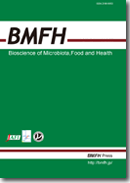巻号一覧

34 巻 (2015)
- 4 号 p. 67-
- 3 号 p. 53-
- 2 号 p. 29-
- 1 号 p. 1-
34 巻, 4 号
選択された号の論文の3件中1~3を表示しています
- |<
- <
- 1
- >
- >|
Full Paper
-
Eriko KISHINO, Naho TAKEMURA, Hisaharu MASAKI, Tetsuya ITO, Masatoshi ...2015 年 34 巻 4 号 p. 67-76
発行日: 2015年
公開日: 2015/10/29
[早期公開] 公開日: 2015/07/11ジャーナル フリーThis study examined the effects of lactosucrose (4G-β-D-galactosylsucrose) on influenza A virus infections in mice. First, the effects of lactosucrose on fermentation in the cecum and on immune function were investigated. In female BALB/c mice, lactosucrose supplementation for 6 weeks promoted cecal fermentation and increased both secretory IgA (SIgA) levels in feces and total IgA and IgG2a concentrations in serum. Both the percentage of CD4+ T cells in Peyer’s patches and the cytotoxic activity of splenic natural killer (NK) cells increased significantly in response to lactosucrose. Next, we examined the effects of lactosucrose on low-dose influenza A virus infection in mice. After 2 weeks of dietary supplementation with lactosucrose, the mice were infected with low-dose influenza A virus. At 7 days post infection, a comparison with control mice showed that weight loss was suppressed, as were viral titers in the lungs. In the spleens of lactosucrose-fed mice, there was an increase in the percentage of NK cells. Lastly, mice fed lactosucrose were challenged with a lethal dose of influenza A virus. The survival rate of these mice was significantly higher than that of mice fed a control diet. These results suggested that lactosucrose supplementation suppresses influenza A virus infection by augmenting innate immune responses and enhancing cellular and mucosal immunity.抄録全体を表示PDF形式でダウンロード (998K) -
Yoshiyuki TANAKA, Kazuyo TAKAMI, Tomohiko NISHIJIMA, Ryo AOKI, Takashi ...2015 年 34 巻 4 号 p. 77-85
発行日: 2015年
公開日: 2015/10/29
[早期公開] 公開日: 2015/07/31ジャーナル フリーBifidobacterium animalis subsp. lactis GCL2505 (B. lactis GCL2505) is able to survive passage through the intestines and proliferate. The daily dynamics of the intestinal bifidobacteria following ingestion of probiotics are not yet clear. Moreover, the effects of long-term ingestion of probiotics on the intestinal microbiota have not been well studied. Two experiments were performed in the present study. In Experiment 1, 53 healthy female volunteers received B. lactis GCL2505; B. bifidum GCL2080, which can survive but not proliferate in the intestine; or yogurt fermented with Lactobacillus delbrueckii subsp. bulgaricus and Streptococcus thermophilus for 2 weeks, and the daily dynamics of intestinal bifidobacteria were investigated. The number of fecal bifidobacteria significantly increased on day 1, and this was maintained until day 14 in the B. lactis GCL2505 ingestion group. However, no significant change in the number of fecal bifidobacteria was observed in the other groups throughout the ingestion period. In Experiment 2, 38 constipated volunteers received either B. lactis GCL2505 or a placebo for 8 weeks. Both the number of fecal bifidobacteria and the frequency of defecation significantly increased throughout the ingestion period in the B. lactis GCL2505 ingestion group. These results suggested that the proliferation of ingested bifidobacteria within the intestine contributed to a rapid increase in the amount of intestinal bifidobacteria and subsequent maintenance of these levels. Moreover, B. lactis GCL2505 improved the intestinal microbiota more effectively than non-proliferating bifidobacteria and lactic acid bacteria.抄録全体を表示PDF形式でダウンロード (744K) -
Hirosuke SUGAHARA, Toshitaka ODAMAKI, Nanami HASHIKURA, Fumiaki ABE, J ...2015 年 34 巻 4 号 p. 87-93
発行日: 2015年
公開日: 2015/10/29
[早期公開] 公開日: 2015/08/05ジャーナル フリーBifidobacteria are known to produce folate, a vital nutrient for humans. Previous studies have suggested that the ability to produce folate is strain dependent, but further adequate evaluation is needed. In this study, a total of 44 strains, including 12 species and 7 subspecies, of bifidobacteria were investigated for the production of folate during cultivation in medium containing essential levels of folate for growth of the tested strains. An in vitro assay showed that all strains of human-residential bifidobacteria (HRB) were able to produce folate, whereas most strains of non-HRB were not, with the exception of the B. thermophilum and B. longum ssp. suis strains. The differences in the in vivo production of folate by HRB and non-HRB were confirmed using mono-associated mice. The fecal folate concentrations, blood levels of hemoglobin and mean corpuscular volumes were significantly higher in the mice colonized with a folate producer, B. longum subsp. longum, compared with mice colonized with a nonproducer, B. animalis subsp. lactis. Our results confirmed the differences in folate production between HRB and non-HRB strains and suggested the benefit of HRB to hosts from the perspective of potential folate delivery.抄録全体を表示PDF形式でダウンロード (738K)
- |<
- <
- 1
- >
- >|